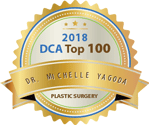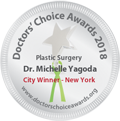 It is sometimes necessary for a plastic surgeon to use a graft in rhinoplasty surgery to create more height and definition in a flat nose, or to restore structure and/or function in a nose destroyed by a previous, unsuccessful nose job, trauma or genetic irregularity. A graft is a custom-sculpted piece of natural material—either cartilage, or a combination of skin and cartilage—that can be used to support weakened nasal structures or cosmetically supplement existing ones. (Note: Material that is used for the same purpose but that is synthetic in origin is called an implant. Read more about nasal implants.) Sometimes, grafts are used in a finesse rhinoplasty procedure to support thin skin in order to camouflage minor irregularities.
It is sometimes necessary for a plastic surgeon to use a graft in rhinoplasty surgery to create more height and definition in a flat nose, or to restore structure and/or function in a nose destroyed by a previous, unsuccessful nose job, trauma or genetic irregularity. A graft is a custom-sculpted piece of natural material—either cartilage, or a combination of skin and cartilage—that can be used to support weakened nasal structures or cosmetically supplement existing ones. (Note: Material that is used for the same purpose but that is synthetic in origin is called an implant. Read more about nasal implants.) Sometimes, grafts are used in a finesse rhinoplasty procedure to support thin skin in order to camouflage minor irregularities.
When there’s sufficient nasal septal cartilage, grafts may be fashioned from the septum, the wall of cartilage that separates your nostrils. Mucous membranes grafts can be easily derived from areas overlying the septal cartilage. Composite skin and muscle grafts can be taken from any area where skin incisions can be easily hidden, for example, in the crease behind the ear. Grafts may also be obtained from your own or banked (donated) rib cartilage.
While the procedure to obtain a graft is relatively simple for the plastic surgeon, and while using natural cartilage and skin may seem preferable to a synthetic implant, neither is without risks. The most common risk may be that you simply do not have enough natural cartilage remaining for the cosmetic surgeon to fashion a graft for the repair. Even if you do have enough material for the graft, there is a risk that the graft may shrink over time or shift with aging. There is also a possibility that the graft may become infected and may extrude on its own, or have to be removed. During your comprehensive consultation in her New York City office, Dr. Yagoda will review your plastic surgery options for functional or cosmetic rhinoplasty surgery, and alternatives with you in great detail.
The Procedure
Rhinoplasty or nose job surgery can be performed in Dr. Yagoda’s New York City office-based surgical facility or in a NYC hospital, under local anesthetic with IV sedation or under general anesthesia. This plastic surgery procedure takes between 45 minutes and two hours. The exact surgical technique is uniquely tailored by the plastic surgeon for each patient but most of the time, all incisions are made internally and there are no visible scars. Sometimes, an incision is made at the base of the nostrils and the incision is carefully hidden.
Recovery
You can return to work in about a week after your plastic surgery and you’ll be able to use a stationary bike or treadmill by the second week. By the third week, you can return to full activities. Although you’ll see immediate improvement, your nose’s shape and your profile will continue to refine over the next 12 to 18 months.
Risks
Like all surgery, rhinoplasty or nose job surgery has certain risks including infection, bleeding, and reaction to anesthesia. Other risks include structural damage to the nose. Dr. Yagoda will discuss these potential risks as well as the benefits of this plastic surgery procedure in full during your consultation in her New York City office.
To determine if you might benefit from rhinoplasty or nose job surgery, call Dr. Yagoda today to schedule your personal comprehensive plastic surgery consultation in her New York, NY office.
Read about Dr. Yagoda’s Facial Plastic Surgery Integrative Post Operative Care Program
Flying In
Dr. Yagoda’s patients come to New York from all over the world. From Qatar to Quebec, we can help you get here from abroad.


































